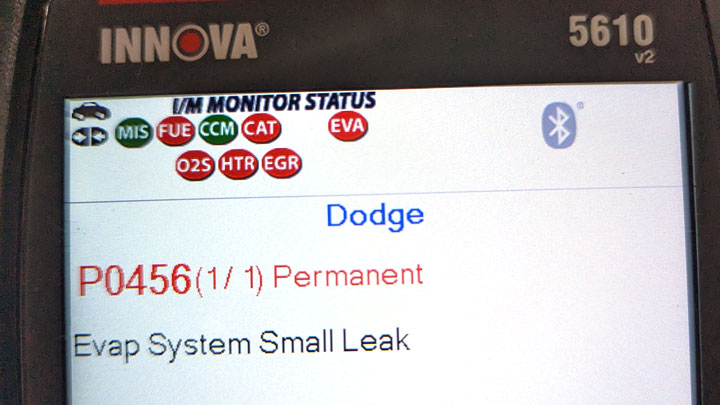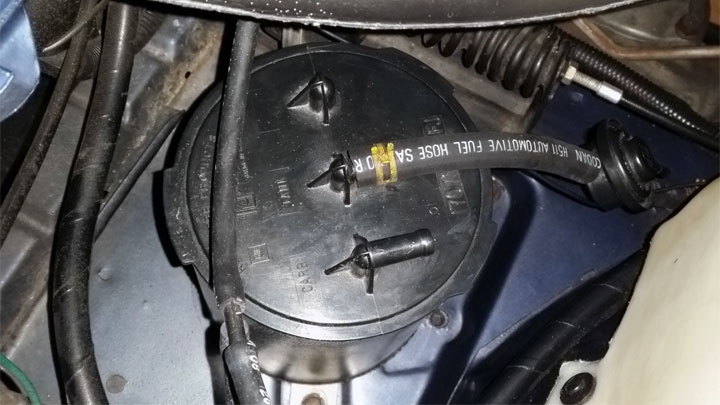P0456 Code (Symptoms, Causes, and How to Fix)
Whether you have a Dodge, Ford, BMW, or other vehicle, don’t panic when the check engine light comes on. Diagnostic trouble codes (DTCs) are there to pinpoint the exact problem.
In the case of a P0456 code, your evaporative emissions system sprung a small leak. Keep reading to see what triggers a P0456 code and how to fix it so you can stop a small evaporative leak before it turns to an expensive repair.

What Does Code P0456 Mean?
The Evaporative Emission Control System (EVAP) plays a crucial role in preventing fuel vapors from escaping the enclosure and reaching the atmosphere.
It is a complex network of valves and hoses transporting these vapors to a charcoal canister to collect them. Once collected in the charcoal canister, the vapors need to go back to the engine for burning.
The computer has to regularly check for leaks in the system to prevent a potential fire and explosion hazard. This means either pumping or vacuuming air from the system and measuring the elapsed time. If the system detects a discrepancy twice in a row, the ‘Check Engine’ light turns on and a code like P0456 displays.
The diagnostic trouble code definition for P0456 is “Evaporative Emission System – Small Leak”, which is similar to P0457. The alternative is code P0455, which indicates larger leaks in the system. P0442 indicates an EVAP leak of the “medium” variety.
See Also: P0449 (EVAP System Vent Valve/Solenoid Circuit)
Will a Code P0456 Clear Itself?
Yes, it’s possible for a P0456 code to clear itself. It mostly happens when the issue causing the code is temporary, such as a loose gas cap.
As soon as the gas cap is properly tightened, the code may clear by itself after a few driving cycles. However, it’s not a guarantee and shouldn’t be relied upon as a permanent solution.
Symptoms of Code P0456

It can be quite tricky to notice the symptoms of code P0456 and correctly identify the issue. This is mostly due to the closed nature of the EVAP system. However, some of the most common symptoms that accompany code P0456 are:
#1 – Check Engine Light On
The first sign you’ll likely notice is the Check Engine Light (or Malfunction Indicator Lamp) illuminating in your dash. This symptom always occurs once the computer detects a leak on the EVAP system.
#2 –Smell of Gasoline
This one is a little less straightforward, as it’s not always easy to smell gasoline fumes from a minor leak. Still, if the issue has been around for a while or the leak is larger than usual, the smell will persist and become noticeable.
#3 – Decrease in Fuel Economy
This one is the hardest to notice because most leaks related to code P0456 are so minor that they do not significantly affect fuel efficiency. But since the EVAP system is supposed to recycle fuel vapors through the engine, a small leak can cause inefficient fuel usage.
Causes of Code P0456

Since the EVAP system is closed, most causes of code P0456 are either on the system components or connections between them. The majority of the system is on the bottom of the car, exposed to the elements and physical damage.
These are some of the most common causes of code P0456 that I’ve encountered in the past.
#1 – Gas Cap Issues
As with any EVAP leak related codes, the gas cap should be the first thing to check. A fuel cap that’s not properly tightened, leaking, or even missing can trigger this code. Always make sure to tighten the cap after refueling, and if you suspect a leak, replacing the gas cap is an easy DIY task.
#2 – Leaking Hoses and Connectors
Leaks in the EVAP vacuum hose or other hoses and connectors in the emissions system can also lead to the P0456 code. Make sure to check all hoses and connections for wear, cracks, or loose fittings. Replace any damaged components that may affect pressure levels in your evaporative emissions system.
#3 – Leaking Fuel Tank
Over time, a fuel tank can become damaged or corroded whether from an accident, bas gas, or even vandalism like adding bleach to your gas tank. This damage/corrosion can then lead to small leaks that affect the evaporative emissions system. Have your fuel tank inspected for any visible signs of damage or leaking, and have it replaced if necessary.
#4 – Purge and Vent Valves
Parts like the vapor canister purge valve help control the flow of vapors in the evaporative emissions system, and if they malfunction, it can cause pressure issues. A multimeter can be used to check for proper electrical function. Replace any faulty valves to correct the problem.
#5 – Leaking Charcoal Canister
The charcoal canister helps absorb and store fuel vapors, and if it develops a leak or becomes damaged, it can affect the overall pressure in the system. Inspect the canister for visible leaks or damage, and have it replaced if necessary.
Is Code P0456 Serious?
Code P0456 is an issue of minor severity and should not drastically affect the performance of the car. The risk of catastrophic failure due to code P0456 is minimal.
However, it’s still important that you take the vehicle to a registered repair shop, so the issue can be taken care of. Failure to do so will likely show up on your next emission testing.
How to Fix

During the process of fixing Code P0456, the diagnostics play a crucial role. Code P0456 leaks are usually tiny and therefore much more difficult to diagnose. This will take up more time; it’s not uncommon for a car to spend a whole day in the shop to find and properly repair the leak.
The procedure is as follows:
- Connect an automotive scanner or reader to the connection and take note of all freeze-frame data that could help determine the time the leak occurred.
- A thorough inspection of the vapor purge valve system takes place, checking all the hoses and connectors, as well as the valve itself. Any damaged components will be replaced.
- Check the purge valve for potential signs of blockage, such as dirt or debris.
- Inspection of both fuel tank and charcoal canister for potential leaks
- Check the operation of the purge valve and charcoal canister vent valve by testing them with a multimeter.
- Use a smoke machine to locate the leak on the EVAP system, along with the test vapor.
- After repairs and replacements, restart the system. Clear the codes from the system and prepare the car for a test drive to see if the code persists.
Cost to Fix P0456
The majority of the costs for the Code P0456 repairs stem from diagnostics. On average, a minor leak issue associated with Code P0456 will set you back between $200 and $300, with the majority of those funds going towards labor and diagnostics.
The replacement of any hoses and valves is often inexpensive. Leaks on the tanks might be more expensive, bringing the cost of repairs into the range of $500 to $600.
- Replace the Engine or Replace the Car? (11 Factors to Consider) - Apr 11, 2024
- Plastic Piece Dragging Under Your Car? (What It Is and What To Do) - Mar 21, 2024
- Timing Belt vs Timing Chain (What’s the Difference?) - Feb 27, 2024

Can a leak in the exhaust pipe cause this code in a jeep Patriot?
I think it’s unlikely. The evap system recirculates fuel vapors so it could be an issue with the charcoal canister or a clog in the evap line.